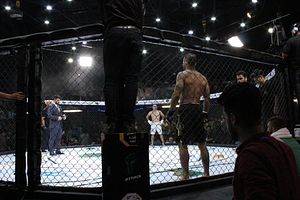Two topics have put Afghanistan consistently in international news in recent months: the Taliban peace process and the country’s national cricket team, which competed in the 2019 Cricket World Cup. Ironically, the topics may not be worlds apart, as stories have emerged about the sport’s popularity with the Taliban.
“Athletes bring entertainment and happiness to the people,” notes 21-year-old Minhajuddin Wahaj, who hails from Maidan Wardak. He’s an amateur fighter, who migrated from Afghanistan to Germany in 2016. Still, he keeps up with the news in his home country.
But the opportunities that the cricket team has to travel and compete, and thus share their success at an international level, are not available to most Afghans. This likely factors into the immense pride that many Afghans show over their cricket team’s recent success.
The Afghan passport ranks last in the world at 199th, according to the 2019 global passport ranking, below Syria, Iraq, and Yemen. This greatly limits ordinary Afghans’ ability to travel and compete on an international scale. Even those working for well-known international organizations face restrictions. For instance, the internationally recognized Afghanistan girls robotics team was denied visas to compete the United States in 2017 until an international outcry encouraged an intervention from President Donald Trump. Eventually, they were granted visas.
Afghanistan’s sports sector has faced similar restrictions. Mixed martial arts, or MMA, has been on the rise in Afghanistan, but fighters traditionally have had to compete abroad to experience success at the level of the cricket team. The top Afghan MMA fighters, such as Baz Mohammad Mubariz, Siyar Bahadurzada, and Nasrat Haqparast, have all competed on the international circuit.
MMA fighter Rohullah Mohammadi, who won a gold medal in kickboxing in Ukraine in 2011, was approached by a scout in the United States after winning a fight in Greece in 2012. When he returned to Afghanistan to present his belt and contract, his passport was confiscated by the Department of Education. He had a special passport from the Olympic Committee but was unable to use it to pursue international opportunities.
“A UF3 scout saw him in Greece and offered for him to fight in the UF3 league,” explained sports entrepreneur Aman Nuristani. “He needed four to five thousand dollars to travel to the U.S. but didn’t have corporate sponsorship.”
Because of corruption and the difficulty young Afghan athletes face traveling, the Nuristani family, Kakail and Aman, established a national Afghan MMA league to create a professional space for Afghans to train and compete. They wanted to bypass extant corruption and create a business model to attract corporate sponsorship to potentially support fighter training and travel costs. Thus the Snow Leopard Fighting Championship, or SLFC, was born.





























